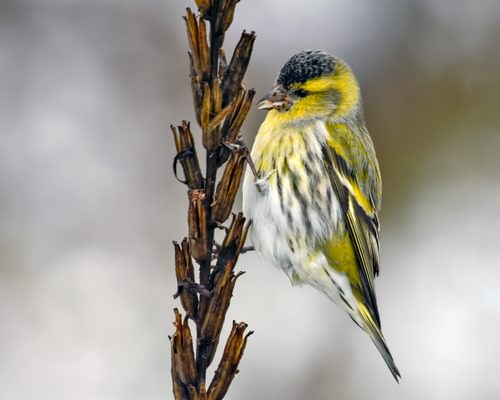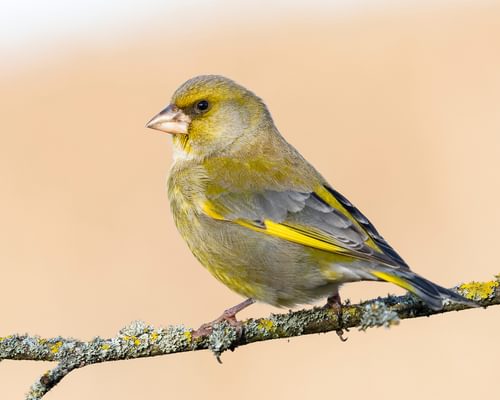European Goldfinch
Least ConcernCarduelis carduelis
Visual Identification
Appearance
The European Goldfinch is a striking small finch with a distinctive red face and black-and-white head. Its wings are black with a bright yellow wing bar, while the body is mainly buff or light brown.
During the breeding season, the bill of male and female goldfinches is white, but at other times of the year, it is marked with a black tip.
Female goldfinches are very alike in appearance to males, and visually, it is hard to tell them apart from a distance. At close range, the sexes can be distinguished by the size of the red facial patch, with the females not extending past the eyes as it does in males of the species.
Juvenile goldfinches do not develop adults' red, white and black facial markings until the late summer or autumn after hatching. Until this point, they have streaky buff-brown markings on their heads.
Size
Length
12cm to 13cm
Wingspan
21cm to 25cm
Weight
14g to 19g
Colours
Males and females have similar plumage
Primary Colour
Red Black White
Secondary Colour
Brown Yellow
Beak Colour
Pale Pink
Leg Colour
Pink
Habitat and Distribution
Habitats
Woodland
Garden
Wetland
Coastal
Urban
Farmland
Grassland
Desert
Tundra
Rainforest
Mountain
Savanna
Distribution
European Goldfinches inhabit open woodlands, hedgerows, parks, and gardens across Europe, North Africa, and western Asia. They prefer areas with scattered trees and shrubs interspersed with open ground rich in seeding plants.
Goldfinches are widespread residents in the UK, with some birds migrating south in winter. They have also been introduced to Australia and New Zealand, where they have established populations.
Elevation Range
Up to 4,200 meters
Climate zones
Temperate, Mediterranean
Distribution Map
This map gives you a rough idea of where you might spot a European Goldfinch. The coloured areas show countries where these birds have been seen.
A few things to keep in mind:
- Birds might not be everywhere in the coloured areas, for example, they may be present around the coast of that country
- Where birds live can change with seasons and available food
- This map is quite simple - it doesn't show exact locations
We're working on making our maps even better! Soon, we hope to show you:
- More detailed maps for bigger countries, including state and region
- How birds move around during different seasons
Distribution by Region
Behaviour and Ecology
Bird Attributes
This feature is in beta. We'd love your feedback to improve it!
Share your thoughtsBird Attributes Explained
Our bird attributes system rates various aspects of a bird's capabilities on a scale of 0-100, based on data from field observations, scientific studies, and expert knowledge.
Attribute Categories:
- Agility: Manoeuvrability, speed, and grace in flight or movement.
- Strength: Physical power, often correlating with size and hunting abilities.
- Adaptability: Ability to thrive in various environments or changing conditions.
- Aggressiveness: Territorial behaviour and assertiveness, particularly during breeding seasons.
- Endurance: Stamina, often seen in migration patterns or foraging behaviours.
Understanding the Ratings:
- 0-20: Very Low
- 21-40: Low
- 41-60: Average
- 61-80: High
- 81-100: Very High
Remember, these attributes are relative to other bird species and don't necessarily indicate superiority.
Hover over the icon next to each attribute for more information.
Tap the icon next to each attribute for more information.
Agility
Reflects the bird's manoeuvrability, speed, and grace in flight or movement.
The European Goldfinch displays remarkable agility, particularly in its acrobatic feeding style. Its ability to cling to thistle heads and extract seeds, coupled with its undulating flight pattern, demonstrates high manoeuvrability and precision in movement.
Strength
Indicates the bird's physical power, often correlating with size and hunting abilities.
As a small finch, the European Goldfinch has limited strength compared to larger birds. However, its ability to extract seeds from tough plant heads suggests some degree of specialised muscular strength in its beak and neck.
Adaptability
Represents the bird's ability to thrive in various environments or changing conditions.
European Goldfinches show good adaptability, thriving in various habitats from woodlands to urban gardens. Their successful population recovery in the UK and establishment in introduced regions like Australia indicate a strong capacity to adapt to changing environments.
Aggressiveness
Measures the bird's territorial behaviour and assertiveness, particularly during breeding seasons.
Generally, European Goldfinches are not particularly aggressive. Their highly social nature, often forming small flocks outside breeding season, suggests a relatively peaceful disposition. However, like most birds, they may display some territorial behaviour during breeding.
Endurance
Reflects the bird's stamina, often seen in migration patterns or foraging behaviours.
While not known for exceptional endurance, European Goldfinches demonstrate moderate stamina. Their partial migratory behaviour and ability to forage extensively for small seeds indicate a reasonable level of endurance. However, as small birds, they likely have limitations compared to long-distance migrants.
Diet
European Goldfinches primarily feed on small seeds, particularly those of thistles, teasels, and dandelions. They also consume seeds from birch and alder trees, and occasionally small insects, especially when feeding young.
Their specialised beak is adapted for extracting seeds from flower heads.
Insects, including bugs, moths, beetles and flies, form a smaller part of a goldfinch’s diet, particularly during early spring and breeding season. Spiders and larvae are also eaten.
Behaviour
European Goldfinches are highly social, often seen in small flocks outside the breeding season. They have an acrobatic feeding style, clinging to thistle heads and other plants to extract seeds.
These birds are also known for their undulating flight pattern, alternating between flapping and gliding.
Vocalisation
The European Goldfinch has a pleasant, tinkling song that includes a variety of sweet trills and twitters. Their flight call is a distinctive 'tickelitt' or 'stichlit', which gives rise to their German name 'Stieglitz'. When feeding or in flocks, they produce a soft, conversational warbling.
Nesting & Breeding
Breeding season for European Goldfinches typically begins in late April. Males perform a fluttering display flight to attract females, often accompanied by song.
Females construct a neat, cup-shaped nest of moss, lichen, and plant down, usually in the outer branches of trees or shrubs. They lay 4-6 pale blue eggs with reddish-brown spots.
Incubation lasts about 12-14 days, carried out by the female. Both parents feed the chicks, which fledge after 13-18 days but continue to be fed by adults for several more weeks.
Lifespan
years
The European Goldfinch typically lives for 2 to 3 years.
Like all birds, lifespan can be affected by factors including predation, habitat quality, disease, and access to food sources.
Conservation and Status
Global Conservation Status
While the European Goldfinch is currently listed as Least Concern, it has faced historical declines due to trapping for the cage-bird trade.
In the UK, conservation efforts and increased garden feeding have contributed to a population recovery in recent decades.
Birdwatching Tips
- Look for goldfinches in open woodland edges, gardens, and fields with thistles and teasels.
- Listen for their liquid, tinkling call, often given in flight.
- Observe feeders with niger seeds, which are particularly attractive to goldfinches.
- In the UK, participate in the RSPB's Big Garden Birdwatch to contribute to goldfinch population monitoring.
Additional Information
Quick Facts
Other names:
Goldfinch
Family:
FringillidaePredators
Main predators include sparrowhawks, cats, and other small birds of prey. Nests may be raided by jays, magpies, and squirrels.
Did You Know?
- Goldfinches were popular subjects in Renaissance paintings, often symbolising resurrection.
- A group of goldfinches is called a 'charm'.
- The population in the UK has increased by over 100% since the 1970s.
- Goldfinches were often kept as captive birds by the Victorians.
Was this bird profile helpful?
Your feedback helps us improve our content
Thanks for your feedback!
Your input helps us improve our content.
Community Experience
Community Ratings
1 rating from birders
Latest Community Reviews
Sarah Thompson
Community Reviews
Create Your Free Account Welcome Back!
Join our community to rate birds and share your experiences. Creating an account is completely free and only takes a minute. Sign in to your account to rate birds and share your experiences with our community.
Your information is secure and will never be shared.
By creating an account, you agree to our Privacy Policy.
FAQs
What are a group of Goldfinches called?
- A charm of goldfinches
- A troubling of goldfinches
- A chirm of goldfinches
- A drum of goldfinches
- A company of goldfinches
- A trembling of goldfinches
- A trimming of goldfinches
Similar Birds
References
- 1 2 3
website: BirdLife International. 2019. Carduelis carduelis. The IUCN Red List of Threatened Species 2019: e.T103764950A152615959.
View source

